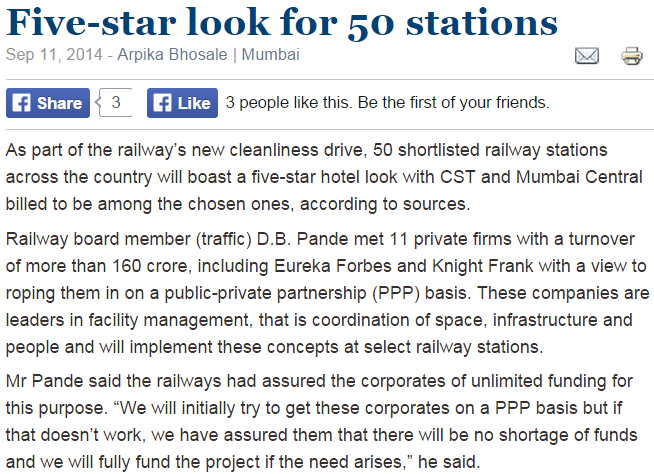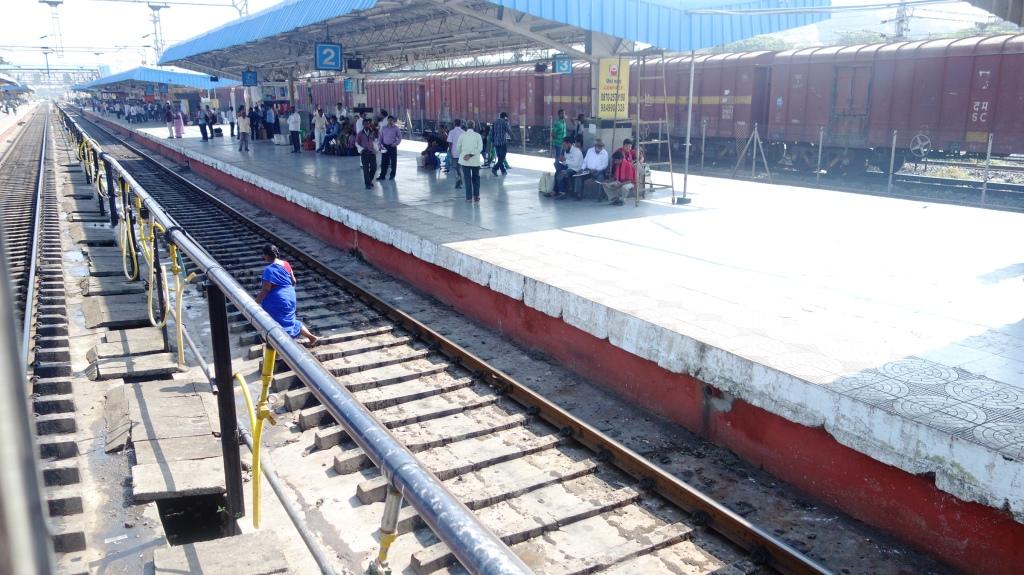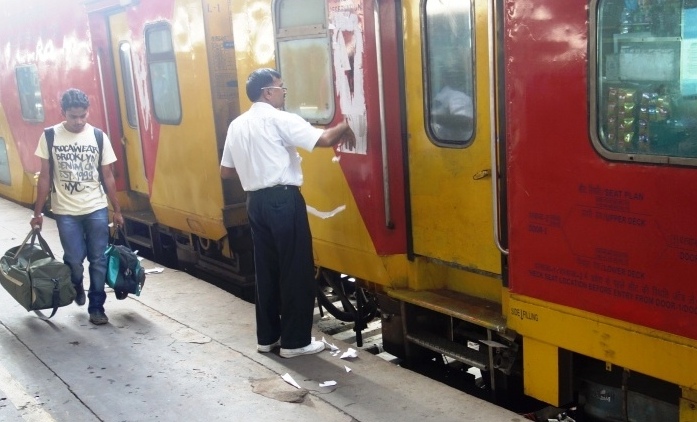Cleanliness Ratings – 1 Star to 5 Star?
There was news the other day that Railway Officials to Learn ‘Upkeep Practices’ From Five-Star Hotels, airports and five-star Hospitals. According to the guidelines, “The Medical Officers/ Commercial Officers who are in-charge of station cleanliness and Chief Health Inspectors (CHIs) should visit well maintained public places like airports, five-star hotels and corporate hospitals to observe and learn from their upkeep practices.” Taking ahead its cleanliness drive, Railways has asked officials to visit airports, five-star hotels, and corporate hospitals to learn best “upkeep practices”.
The other news states exploring cleanliness options through PPP options-
Cleanliness has been a challenging subject since ages and only increasing day by day with more and more development, producing equal filth, garbage, scrap, air, and water pollution. With an economy expecting to grow by 8-10% in the next five years, the garbage will also increase in the same proportion. Will we be able to handle this level of garbage generation considering the state we are in today?
Indian Railway has always shown positive intent towards cleanliness be he the Station Manager or Divisional Railway Manager. Cleanliness during the day and illumination during the night has an immediate positive role in image changeover. In order to drive home the message of cleanliness, a new term ‘Five Star’ has been coined by IR. Is it possible for Railways to match with Five-star hotels, hospitals, airport, etc.? I don’t think so when clientele of five stars pays Rs. 10000/- for one night stay and 50 times the fare for travel and certainly looking for higher levels of cleanliness and orderliness.
What is 5-star cleanliness?
There is no standard which defines 5-star cleanliness. The star rating made its beginning with the facilities that exist in the hospitality sector like hotels. The cleanliness standards for one star to 7 stars are the same and there is no demarcation for different levels in the category of cleanliness. Therefore, 5-star is not a standard of cleanliness, but terms coined to send a message for the adoption of the best in the industry of cleanliness. Yes, Indian Railway may consider the system of star ratings by encompassing all aspects of passenger amenities at a station with auditing by an outside agency. But very unlikely, Indian Railway can accept such a challenge.
The effort on behalf of Indian Railways towards cleanliness is giving a strong feeling that IR has failed to understand its core values on which it has survived during the last 160 years. Indian Railways knows well the complexities of the cleanliness challenge and is not comparable with any of the star rated sectors, it is looking at. Then why trying to replicate the nourishment required for growth of apple for a guava plant? There are 100s of stations in Indian Railways with comparable complexities, but varying levels of cleanliness level. Why not set the level of 1 star to 5 stars cleanliness based on the standards adopted by the local Railway administration at these stations. It is reasonable to choose 5 levels of complexities depending on the level of traffic, the share of local and long distance trains, a number of platforms, outside interference, the discipline level of the city, etc.
It is an inward looking approach termed as the most effective technique to improve one-selves and equally applicable to organizations. Indian Railway shall explore and discover the powerful ability that exists within it to transform and set the cleanliness standards.
What are the steps towards inward looking?
- Define the boundary limits of a Railway station with a direction to station management about the responsibility of cleaning and upkeep. Fix responsibility with only one department for the entire station. The contracting agency if considered for cleaning, the same shall be entrusted to one agency only to avoid any conflict.
- Fixing norms for provision of dust bin depending on the size and number of platforms, and the number of passengers handled daily. Every dust bin shall be provided with a polythene bag for easy removal of the collection. There shall be two dust bin at each location one for bio-degradable and another for non-degradable garbage. The stall owners shall be engaged in counseling of passengers for throwing the remains of the article purchased in the dust bin. Every shop shall also have its own garbage collection arrangement. The schedule of replacement of the garbage polythene bag in a day shall be decided based on the trend of garbage collection.
- Broom sweeping shall be banned and instead introduce a system of picking the garbage particle and vacuum cleaning. Broom sweeping is not a sustainable method of cleaning large areas.
- The entire area shall be considered for covering by a) concrete b) grass c) road d) water bodies e) track ballast, etc. and nothing of mother earth shall be visible. Even if there is a little patch of mother earth, visible, it shall be covered by higher size particles so that it reduces erosion and dust generation during heavy wind.
- A mechanized cleaning system shall be a must for all contractors with the list of machines to include vacuum cleaning, steam and normal high-pressure water jet cleaning of floor and washable apron, wet and dry mopping, etc. Every machine shall be fitted with an energy meter or any other means to record the working hours of the machine.
- In view of the usage of a Railway station round the clock, two cycles cleaning will not work and may need a minimum 4-5 cycle depending on the usage. In shopping malls, an alert person is deputed to pick up the garbage and mop the affected area to keep it always clean. Such measures will also be required at Railway stations if IR wants to demonstrate round the clock cleaned environment.
- Repairs to platform surface, leaking taps, hanging cables of electrical and communication, a disorder in the advertisement is also a part of cleanliness and orderliness for the 5-star image of a Railway station. Minor engineering repairs shall be built into the cleanliness contact to be called as Cleanliness-Orderliness contact.
- There is a system of stock-taking while handing over eatables to catering staff of Rajdhani and Shatabdi Express trains. On similar lines, the remains of the eatable called garbage shall be handed over at the terminal or nominated station to the authorized agency and questioned if it is less. Polyethylene bags shall be provided in each passenger cabin to keep the garbage which shall be collected at the nominated station. This will help in curbing the tendency of throwing the garbage out of the window. Provision of dust bin at each end of the coach on lines similar to 2A and 3A is planned, but it will not work in SL class, due to natural lethargic attitude existing for which he will continue to throw the garbage outside the window.
It is not that Indian Railway is silent on its role towards Swachh Bharat and its action plan is available at http://www.indianrailways.gov.in/railwayboard/uploads/directorate/traffic_comm/ACTION_PLAN_SWACHH_BHARAT.pdf
How to work with motivation and morale of the manpower engaged in cleaning activity?
Irrespective of the source for manpower engaged in cleaning activity that is contractual or departmental, the morale and motivation level is generally very low. Everyone looks on these staff with contempt and treating the work as well person as menial. What is the motivation for these staff to do their best and proud of the profession? Have we ever discussed with this group of staff about how to improve ways and methods of cleaning standards? Either it is none or very rare. In order to sustain a cleanliness drive for “Swachh Bharat” following action shall also be taken simultaneously.
- The cleaning staff shall not engage in cleaning activity without wearing a uniform and safety gear for his own health and easy identification.
- The work of cleaning shall be considered as a skilled work and staff shall be trained in the essentials of cleaning work such as identification of bio-degradable waste, hazardous waste, side effect of sweeping with broom, choking of drains and its effect, how to make sure free flow of water in the drain, growth of mold and algae in drains, operation and handling of cleaning machines, productivity of a machine and most importantly in counselling the passengers to use the dust bin instead throwing towards the track.
- The cleaning staff at a station shall be motivated to form a group called Quality Circle group to find the problem, brainstorming, finding a solution, implementing the solution, deriving benefit and give a presentation to the management. This exercise of the quality circle is the best motivational technique when the staff feels engaged physically and mentally in his work.
- Annual cleanliness Sheild was introduced long back in which stations in three categories are evaluated by a committee of three senior officers and awarded to the best station. Everyone knows how the shields are decided and awarded and have not worked well. Another aspect is that the credit of cleaning award shield is taken by the management and not by the staff involved in this.
The responsibility of Railway Staff towards cleanliness
It is not the passenger involved in garbage generation, but also Railway staff, Stall Owners, Porters, etc. numbering around 500 at a major railway station. Has IR ever punished these erring persons? It is easy to find such an erring person by the way garbage generated by them. It is easier to handle them with counseling, disciplinary action, suspension of license, etc. and will send a strong message to all concerned about IR resolve towards this mission.
Railways has always been a trend setter in the field of technology, development, innovations, cost effectiveness, management of resources, transportation, than why looking at others for a non-technical issue. It should explores its intrinsic value and dwell upon its strength to prove its value.
You may also like:
- Where has 150 millions Indian Railway passenger gone?
- ‘Rescue’ Indian Railway passenger business through statistical indices ‘RSKU’
- Average speed of freight train over Indian Railways
- Mechanized measurement and inspection – a help to cut down…
- Why IR passenger traffic heading south?
- Why no steps to digitize issue of free travel pass…


